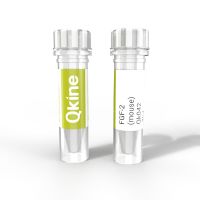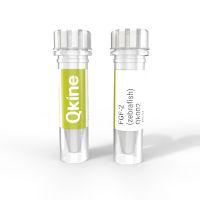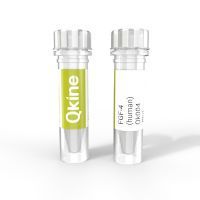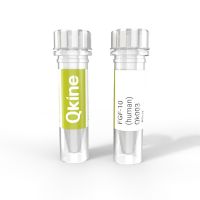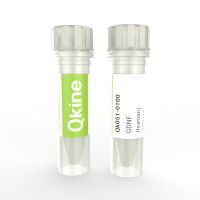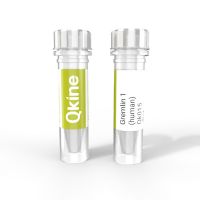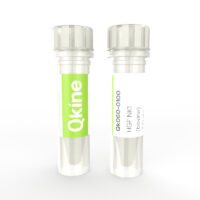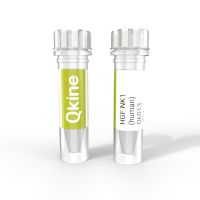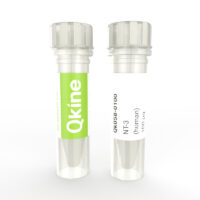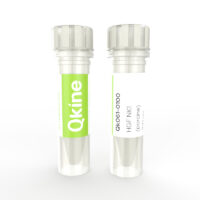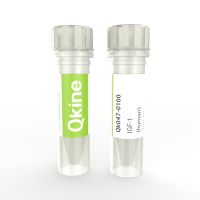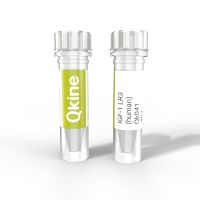- Recombinant mouse FGF2 protein/ bFGF is an important factor in the maintenance of mouse epiblast-derived stem cells (EpiSC). Mouse naïve pluripotency is maintained by LIF, BMP4, and Wnt signalling pathways. However, the primed state of pluripotency in mouse EpiSCs is more similar to hESC and hiPSC, being maintained by FGF2 and TGFβ/Activin/Nodal pathways.1,2High purity and bioactivity 16 kDa murine bFGF / FGF2 (basic FGF) protein, animal-origin free (AOF) and carrier-protein free (CF).
- Zebrafish FGF-2 protein (bFGF/basic FGF) has been used extensively to support the maintenance and proliferation of human and mouse induced pluripotent (iPSC) and embryonic stem cells (ESC); used in the original Ludwig et al feeder-free culture of embryonic stem cells protocols 1-3. High purity 17 kDa FGF2 / bFGF protein, animal-derived component free (ACDF) and carrier-protein free (CF). This version of recombinant zebrafish FGF2 is used by the core facility at the Cambridge Stem Cell Institute, UK and historically by many of the stem cell groups based at University of Cambridge.
- Human FGF-4 protein is used for the proliferation and differentiation of embryonic and induced-pluripotent and tissue (mesenchymal) stem cells and promotes neural stem cell proliferation. FGF-4 is an important component of cardiac, intestinal and other organoid culture media.High purity and bioactivity 14 kDa, bioactive domain of human fibroblast growth factor 4, animal origin free (AOF) and carrier-protein free.
- Human/rat/porcine/bovine FGF10 protein promotes lung organoid formation and induces branching morphology. FGF10 protein is used widely in organoid culture, embryonic stem cell (ESC) and induced-pluripotent stem cell (iPSC) differentiation, and for the study of epithelial to mesenchymal transition and tumor metastasis.High purity and bioactivity 17 kDa, bioactive domain of human fibroblast growth factor 10, animal-free (AOF) and carrier-protein free (CF).
- Glial cell line-derived neurotrophic factor (GDNF) is a member of neurotrophin family and GDNF family of ligands (GFL). GDNF plays a crucial role in the development, growth, and survival of neurons in particular midbrain dopaminergic neurons. It promotes the axon growth and innervation of dopamine neurons. GNDF is used to maintain neurons and cortical organoids and to differentiate dopaminergic neurons from human pluripotent stem cell-derived neural progenitors. GDNF also facilitates the differentiation of neural progenitors to astrocytes.Recombinant human GDNF bioactive 30 kDa homodimer. This protein is animal-free (AOF), carrier protein-free, and tag-free to ensure its purity with exceptional lot-to-lot consistency. Qk051 is suitable for the culture of reproducible and high-quality cortical and motor neurons and cortical organoids.
- Human/bovine/porcine Gremlin 1 protein is a BMP-inhibitor present in the natural intestinal niche and provides an alternative to Noggin for optimisation of intestinal organoid culture and iPSC differentiation.Qk015 has been optimized by our experts for exceptionally high-purity production in E.coli and bioactivity. 18 kDa high purity dimeric protein, animal-free and carrier protein free
- Recombinant bovine HGF protein is a potent, high-purity NK1 isoform of bovine hepatocyte growth factor (HGF). Bovine HGF differs from human HGF at several key amino acid residues that are predicted to affect bioactivity and receptor binding. Use of species-specific HGF growth factor will facilitate media optimization for cellular agriculture (cultivated meat) and veterinary applications. Also available is Qk061 Porcine HGF (NK1). The highly scalable animal-free manufacture and enhanced bioactivity make this suitable for chemically-defined media and reproducible scale-up.20kDa naturally occurring isoform of HGF, animal-free and carrier-protein free.
- Hepatocyte growth factor (HGF) is a multi-functional cytokine that promotes the growth and proliferation of various cell types including mesenchymal, endothelial, and epithelial cells. It is involved in embryonic development, cell motility, survival, angiogenesis, and tissue regeneration. In cell culture, HGF is used to promote the differentiation of mesenchymal cells towards hepatocytes, osteocytes, and endothelial cells. Recombinant human HFG NK1 protein is a potent naturally occurring isoform of HGF. This protein is animal-free, carrier protein-free, and tag-free to ensure its purity with exceptional lot-to-lot consistency with a molecular weight of 20 kDa. It promotes efficient differentiation of human induced pluripotent stem cells to hepatocyte-like cells at just 10 ng/ml with highly homogeneous expression of the hepatic marker, HNF4α.
- Neurotrophin 3 protein is part of the neurotrophin family and plays a crucial role in embryonic development and the maintenance and neuroprotection of the adult nervous system.NT-3 protein is used in cell culture to promote the differentiation and survival of specific neural subpopulations in both the central nervous system and peripheral nervous system such as sensory neurons, cortical neurons, and oligodendrocytes. It is also involved in the maintenance of endothelial cells and myocardial cells.Recombinant Neurotrophin 3 protein is a non-covalently linked homodimer with a molecular weight of 27.3 kDa.Qkine NT3 protein is animal-free (AOF), carrier-free, tag-free, and non-glycosylated to ensure its purity with exceptional lot-to-lot consistency. It is suitable for the culture of reproducible and high-quality cortical neurons and oligodendrocytes.
- Recombinant porcine HGF protein is a potent, high-purity NK1 isoform of porcine hepatocyte growth factor (HGF). Porcine Recombinant Protein HGF differs from human HGF at several key amino acid residues that are predicted to affect bioactivity and receptor binding. Use of species-specific HGF growth factor will facilitate media optimization for cellular agriculture (cultivated meat) and veterinary applications. Also available is Qk060 Bovine HGF (NK1). The highly scalable animal-free manufacture and enhanced bioactivity make this suitable for chemically-defined media and reproducible scale-up.20kDa naturally occurring isoform of HGF, animal-free and carrier-protein free.
- Human IGF-1 protein (IGF-I), insulin-like growth factor 1, is used in the maintenance of human pluripotent stem cells and is necessary for cell growth in the absence of insulin1. IGF-1 promotes the proliferation of many cell types, including mesenchymal stem cells, in vitro.Highly pure and bioactive 8 kDa IGF-1 protein, animal-free (AF) and carrier-protein free (CF)
- Human IGF-1 LR3, insulin-like growth factor long arginine 3, protein is a synthetic analog of IGF-1. The substitutions include an Arginine substitution and an N-terminal protein extension. Consequently, IGF-1 LR3 has improved biological potency and extended half-life.Highly pure and bioactive 9 kDa IGF-1 LR3 protein monomer, animal-free (AF) and carrier-protein free (CF). IGF-1 LR3 is often used in the maintenance of human pluripotent stem cells [1].
